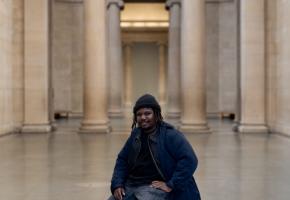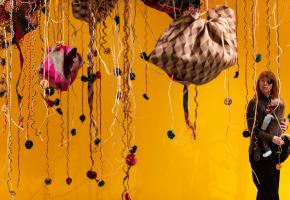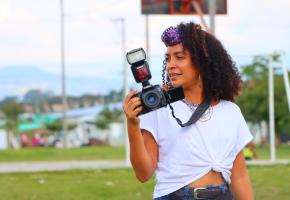Cinalli has indulged in a life- long desire to pay tribute to Picasso” and "the installation”, as the artist describes it, is formed by a group of beautifully executed ‘copies’ of Picasso’s “Têtes de Femmes” paintings, that together from a utopian experience for the visitor and the effect is stunning.
Having started out studying psychology and Philosophy, he turned to the arts and studied at Harrow School of Art and subsequently at Hornsey College of Art in London. He remains based in London, although he is often abroad working on major commissions, including the vast fresco in the new Capella y Chiessa di Santa Maria della Misericordia in Umbria, and the Vintners Palace in London .
This exhibition is, therefore, a break from his normal work and he has thoroughly enjoyed the challenge.
“This exhibition is one unit, a totally improbable ‘installation’ of, I am not sure how many Picassos, where I tried to create them in a particular way. The frames were meticulously hand-crafted individually for each painting. Suresh Singh, the architect, helped me construct the frames, as apart from being an architect, he is a great carpenter! He made the basic structures and I worked on them adding plaster and paint, to create a sense that they could be Picassos, identical, except, of course, for the fact that they have completely different sizes, (to the originals) so as to avoid any confusion. In fact , that was far from my real intent, I don’t want the paintings to be viewed individually, but to form part of an experience as a whole. “

It is interesting to have these images grouped together in this way as in reality, it would be totally impossible to achieve. No one even knows where a number of them are located, it is not known if they are in a bank vault, or a private collection. That is why they have called the show a utopian experience, this installation in reality would be an impossibility, thus the gallery visitor’s perceptions are challenged:
“ …you would feel confused, you would not know if it was real or not, you create a sense of ambigüity and ambivalence in the concept, but evidently, within that ambivalence there is that strong concept, if that is what you want to call it, because it is not that, not this other, but itself”.
Andrea Harari, the curator and Gallery owner, is a personal friend of Cinalli and having come across a Picasso in his studio, that he had painted some time ago, for an earlier exhibition called “Viva Picasso” the idea arose to create this new installation, partly because in it, so many themes converge. There is the issue of copies, forgeries and reproductions as Andrea describes:
“There is also the theme of authenticity that you must have in order to say that a particular work is a masterpiece, or not, why should these not be considered and yet a PIcasso is? Because on certain levels, these are (masterpieces) for me, and so there are a multitude of themes behind (this concept) that beg questions that relate directly to our actuality too.”
Andrea Harare and Ricardo Cinalli
The idea behind the show was to plant a seed of doubt in the observer, and create a unique experience. Ricardo Cinalli was confident that it was an original idea.
“There has never been anything like it. I was trying to think if I had ever heard of something similar, but I don’t think so. Firstly for a variety of reasons, because normally it would be risky, no one is going to exhibit in this way, because if they are copies they could be illegal, and you could be jailed. But to exhibit them in a public space under the umbrella of the concept of an installation, as ‘Conceptual Art’, then … with the umbrella we are legally protected.”
With this in mind, Andrea Harari pointed out the importance of detail in the idea.
“If the works had not had frames, it would have been like a (factory) shop in Vietnam, where they make reproductions: they paint Gauguin, Cezanne, Seurat, whoever… but that was not the objective here… We wanted to plant the seed of a doubt, so with these frames, and the way that they are presented , with Ricardo’s talent in painting them, because it is very difficult to paint a Picasso as well as this… it all adds up to a very unique experience. … This is a fun show, different and ingenious, so much so that Ricardo and I both enjoyed ourselves. I like to think that Picasso would have enjoyed himself too, had he seen it, as well as the public. … One is playing with those five seconds of people’s perception , that moment of doubt and confusion, when they first spy the exhibition through the window… that is what amuses me, that challenge, and I hope that it moves something in the viewer, that he cannot be indifferent and that he then leaves the gallery with a different perception.”

Some people have thought that the exhibition was timed to coincide with the massive Picasso portraits exhibition a the National portrait Gallery, but it was pure coincidence, the curator Andrea and the artist Cinalli were so busy with the preparations for their own exhibition they had failed to notice the exhibitions would run concurrently.
The whole intimate process of painting the Picassos was very moving for the artist.
“Can we ever really ‘know’ Picasso? A monster like that? How could one get to really know him? However, when you paint his works, you submerge yourself in the material and the way that he resolves the mathematics of the Faces, of the heads, not so much during the neo- classical years but the cubist period, the years when, in effect he arrived at Cubism proper. He followed different currents, different times, going backwards and forwards without any specific rules, even though it can be established when he painted each painting, but there is a coming and going, something that I can understand as I do that with my own work. Eventually you feel you have got into his head, and then you go Wow, he was really something! You get close, into the flesh, you grow an understanding of him with each paint stroke, you get right into his psyche and under the skin. It was very interesting”

http://www.jaggedart.com/artists/ricardo-cinalli
http://www.ricardocinalli.com/ricardo-cinalli-documented-bio-english.pdf

















